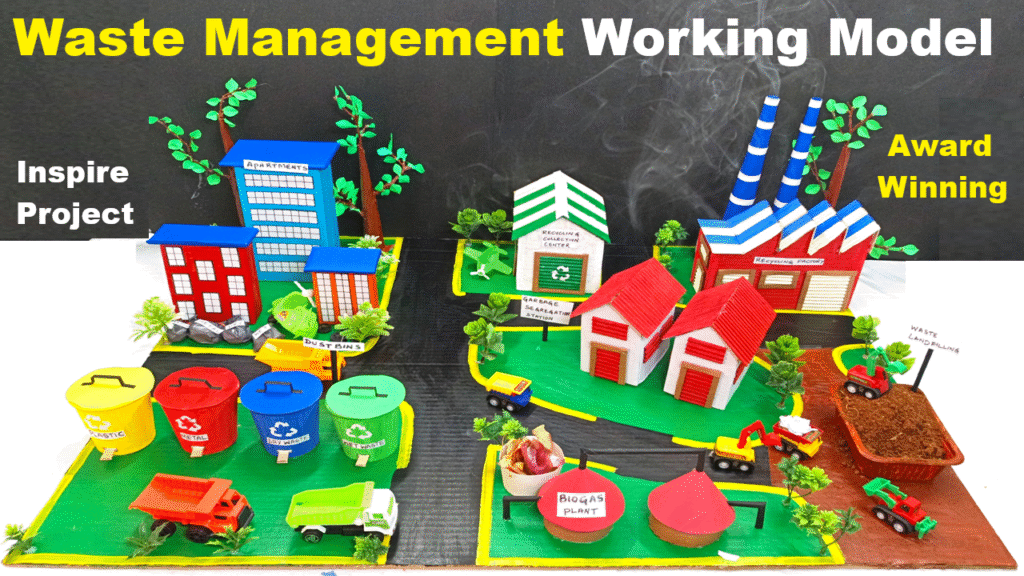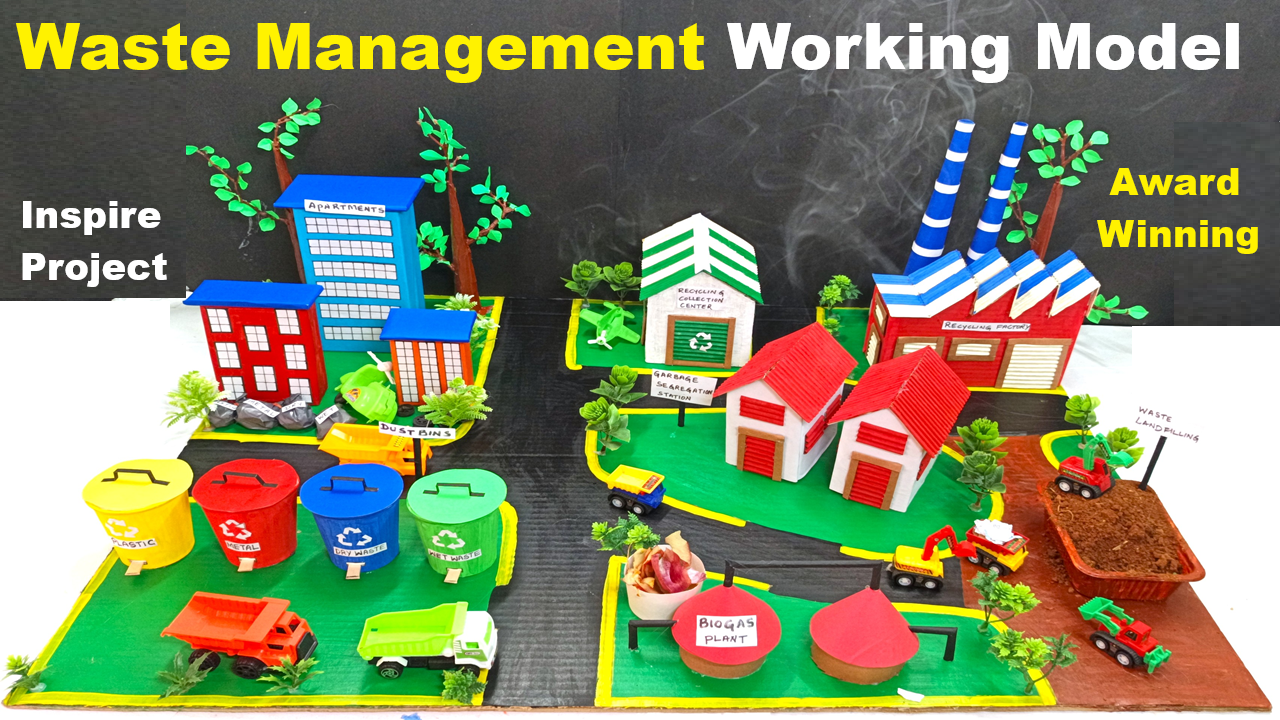Introduction
Waste management is one of the greatest challenges of our time. With increasing urbanization and population, the amount of waste generated daily has risen drastically. If not managed properly, waste leads to pollution, health hazards, and environmental degradation. The solution lies in segregating waste, recycling materials, generating energy, and disposing non-recyclables safely.

This working model demonstrates the entire waste management cycle in a simple and creative way. It includes:
- Four colored dustbins for waste segregation.
- A biogas plant to generate fuel from biodegradable waste.
- A recycling factory to process recyclable items.
- A waste landfill site for final disposal.
- A garbage segregation unit to show separation of mixed waste.
The model is designed as a DIY project using materials like cardboard, paper cups, ice cream sticks, straws, and paint.
Objectives
- To demonstrate the importance of waste segregation at source.
- To show how biogas plants convert biodegradable waste into energy.
- To explain the process of recycling plastic, paper, and metal waste.
- To highlight the role of landfills in safe disposal of non-recyclable waste.
- To spread awareness about scientific and sustainable waste management practices.
Materials Required (DIY Low-Cost)
- Cardboard sheets (base and background structures).
- Paper cups (to represent dustbins, biogas tanks, factory towers).
- Ice cream sticks (for levers, fences, chimneys).
- Plastic bottles (cut for tanks, chimneys).
- Chart papers (green, blue, red, yellow, grey, black).
- Glue/Fevicol and tape.
- Scissors and cutter.
- Sketch pens and paints for labeling.
- Cotton, thermocol balls, or clay for representing waste.
Step-by-Step Model Design
1. Four-Colored Dustbins
- Place four paper cups on one side of the model.
- Paint them in green, blue, red, and yellow.
- Label them clearly:
- Green → Biodegradable waste (food, peels, leaves).
- Blue → Recyclable dry waste (paper, plastic, metals).
- Red → Hazardous waste (chemicals, sanitary waste).
- Yellow → Biomedical waste (masks, syringes, bandages).
- Demonstrate dropping waste (cotton, paper bits, foil pieces) into the respective bins.
Concept Shown: Waste segregation at the household level.
2. Garbage Segregation Unit
- Construct a small sorting platform using cardboard.
- Make miniature conveyors with strips of paper.
- Place different waste items (paper bits, seeds, foil, plastic) to show segregation.
- Add labels like organic waste, plastic recycling, hazardous waste, etc.
Concept Shown: Secondary segregation when waste is mixed. Machines or workers separate items to send to proper treatment units.
3. Biogas Plant
- Use a plastic bottle or paper cup as the digester tank.
- Connect a straw or pipe to represent the gas outlet.
- Place cotton or clay inside to represent organic waste.
- Add a small balloon at the end of the straw to show gas collection.
How It Works:
- Biodegradable waste undergoes anaerobic decomposition inside the tank.
- Microorganisms break it down to produce biogas (methane + carbon dioxide).
- The gas can be used for cooking and lighting, while the leftover slurry becomes organic fertilizer.
Concept Shown: Converting waste into renewable energy.
4. Recycling Factory
- Use a cardboard box or paper cup tower as the factory.
- Add a chimney made from rolled chart paper.
- Draw or paste pictures of bottles, cans, and paper sheets to represent recycling.
- Explain that plastics, metals, and paper collected in blue bins are sent here.
Process Demonstrated:
- Sorting – Plastics, paper, and metals separated.
- Processing – Plastics melted into granules, paper turned into pulp, metals melted.
- Re-use – Recycled material is used to make new items.
Concept Shown: Recycling reduces waste and saves natural resources.
5. Waste Landfills
- Use a cardboard pit or box covered with black chart paper.
- Layer it with cotton, soil (brown chart), and small waste pieces.
- Cover partly with another cardboard sheet to show buried waste.
- Mark it as Landfill Area.
How It Works:
- Non-recyclable and hazardous wastes are dumped into engineered pits.
- Layers of soil cover waste to reduce smell and pollution.
- Modern landfills also include plastic lining to prevent leakage into groundwater.
Concept Shown: Safe disposal of unusable waste.

